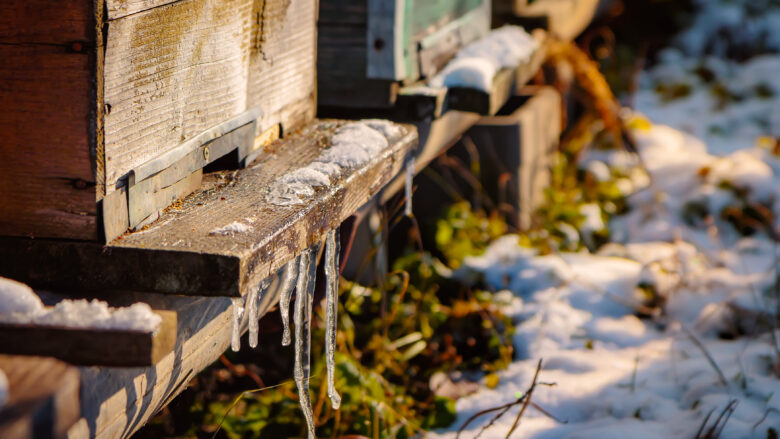by David Papke
It is hard to bee observant in the dead of winter. The barren trees and brittle fields seem empty of any promise of spring or summer’s abundance. Yet one notices the bluebirds investigating their nest boxes or squirrels gathering dried leaves for theirs, a red-tailed hawk rides the airwaves overhead and in the snow-covered apiary there are the meandering tracks of deer and rabbits and fox, and the occasional curious beekeeper.
Early February: On any sunny day when the temperature reaches the 50’s, if I walk through the apiary the bees are flying, with lots of activity at the entrance holes. Not every colony equally - some more than others -but purposeful activity. Coming and going, either cleansing flights or foraging, but also orientation flights; individual bees responding to the colony’s needs by joining the force of foragers. It is a noticeable flight pattern: a bee appears at the entrance, pauses and then flies out, turns to face the hive’s entrance, slowly circling around in ever-widening loops, gradually farther and farther from the hive until finally she turns to fly away, but usually only momentarily before returning to the entrance. This is most likely repeated until the spacial memory is fixed and she ventures out into the wider landscape to learn its features as well. Once recognized, a beekeeper will remember this behavior and often notice it at other times of the year. In the summertime it seems to happen at a particular time of the day, usually mid-afternoon and several colonies may simultaneously be exhibiting orientation flights.
Sometimes beekeepers confuse orientation flights with swarming or robbing; in all three scenarios an unusually large number of bees are in the air and around the entrance. However, with close observation one can distinguish one from the other by the bees’ behavior. Notice in swarming the tremendous number of bees simultaneously taking to the air, almost as if they were being pushed out of the entrance and that their flight seems erratic or disturbed (they are in fact seeking the queen’s scent that will guide them to bivouac nearby). Notice in robbing the agitated behavior at the entrance and other bees seeking ways to enter the hive. In the apiary, a large number of bees will be seeking the source of honey to rob including testing the entrances of other colonies.
To me, in contrast, orientation flights seem a much more peaceful affair.
Mid-February: Watching the weather forecast I could see it coming - a single unusually warm day, 72 degrees and sunny. At the home yard the bees are especially active - orientation flights and every colony bringing in a variety of pollen in various colors: pale green, bright orange, both pale and bright yellow (I should walk about and try to identify the sources but know that adversity of pollen sources is good for the bees and also intentional).
But the best part of this special late winter day comes at the Millbourne apiary where Chris, the head groundskeeper, asks me if I have time for a short walk - he has something he’d like to show me. We walk behind the mansion to an area I’ve never been before, past the pond to a grove of old pine trees. As we approach, I catch the glint of flashing wings in a patch of sunlight and sure enough there are honey bees coming and going from behind an old pine.
Around the backside I find a long fissure in the trunk, tight near the top and opening up near the ground where the honey bees are coming and going, bringing in pollen. I can’t imagine a very large cavity inside this trunk but the colony has obviously survived the winter and is raising brood. I am surprised and delighted; Chris seems pleased to have shown me. Most likely its a swarm from one of my own colonies that chose this spot over one of my bait boxes. Their location is out of the way so we agree to let them be and watch what happens.
Millbourne is a private arboretum where I’ve maintained an apiary for 20 years; it’s a great location, the diversity of trees and plantings make it special, and I get along well with Chris and the other groundskeepers. He told me that his crew has become more bee-aware with the apiary there and that they are noticing fewer pollinators in general. They should know; they work with the plants and trees in an ecosystem where species cohabitation and interdependence play an essential role. I told him about reading Dave Goulson’s Silent Earth: Averting the Insect Apocalypse and how all insects are in decline worldwide. I’m sure he understands the implications of that and it is a grave concern (for both of us).
Beekeepers everywhere should be concerned as well. Managed colonies are not excluded; they live in the same environment as other insects and face many of the same challenges. To be truly observant one needs to look beyond the hive and the apiary to see that all life is not only connected but also mutually dependent.
Question: In an increasingly fractured and chemically polluted landscape what can a beekeeper do to mitigate the effects of environmental degradation on his/her colonies and other pollinators as well?
[Return to February 2025 Beeline newsletter]

